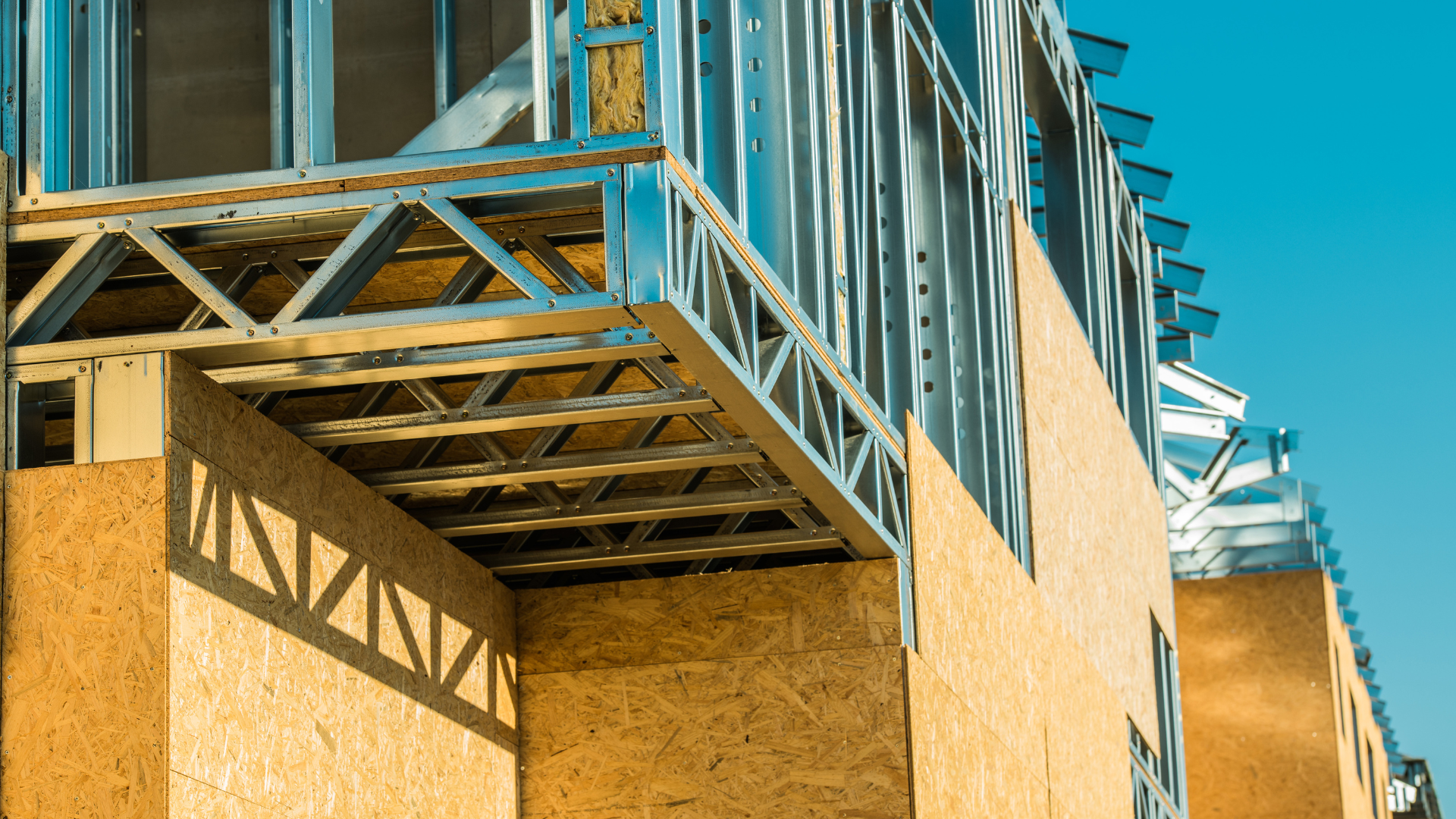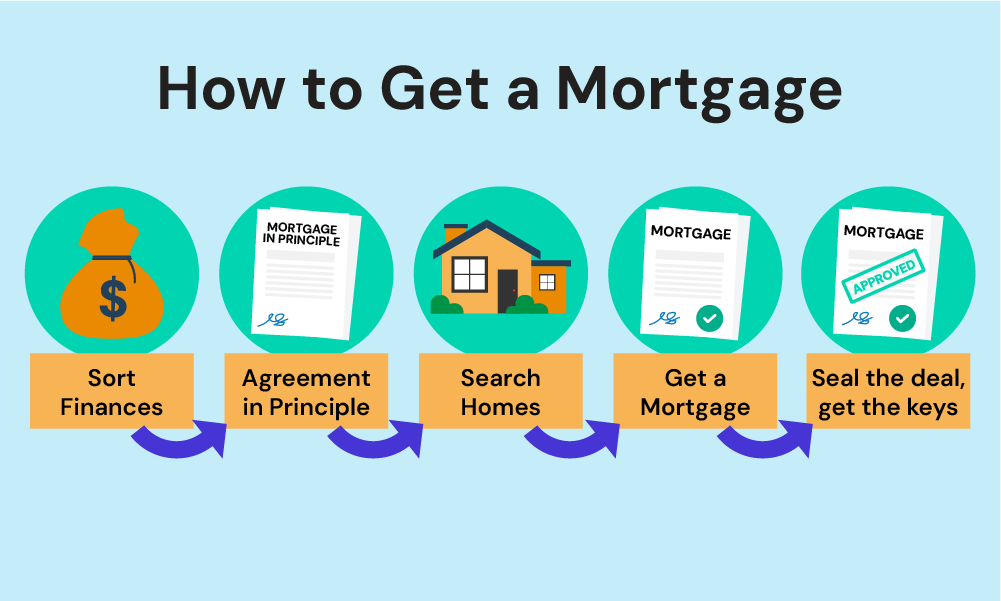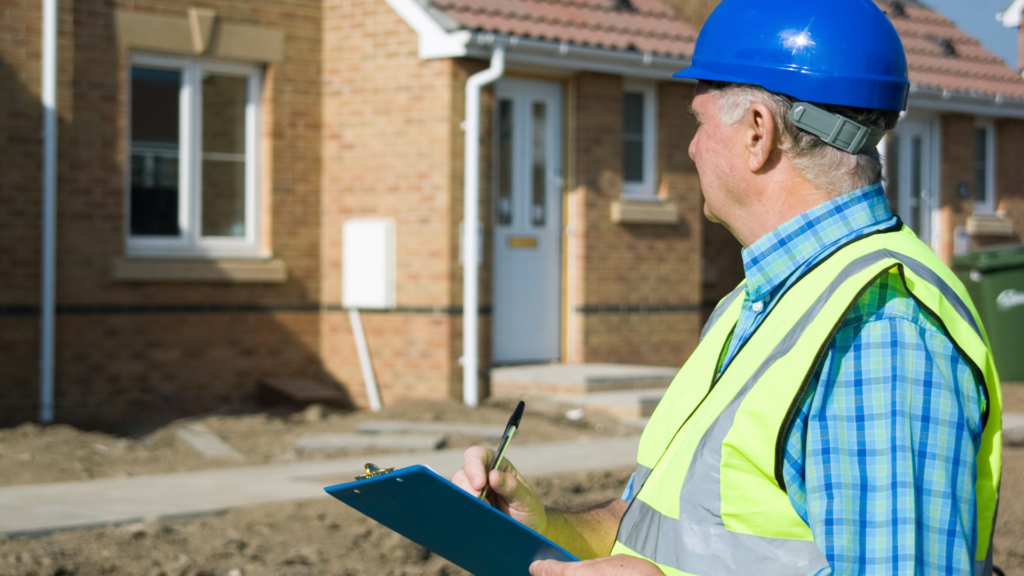- What is a Steel-Frame House?
- Steel Frame Construction Types
- The Pros and Cons of Buying a Steel Frame Home
- Can You Get a Mortgage on a Steel Framed House?
- How About Insurance?
- Do You Qualify for a Mortgage?
- How Much Can You Borrow?
- How Much Deposit Do You Need for a Steel Frame House?
- How To Get a Mortgage For a Steel Frame Home?
- Can You Get a Buy To Let Mortgage for Steel Structured Houses?
- Key Takeaways
- The Bottom Line
Steel Frame Construction Homes: How to Get a Mortgage?

Steel-framed houses have been around for a while, and they’re still a popular choice for good reasons. They’re strong, resilient, and offer some great design flexibility.
However, lenders consider steel-framed homes “non-standard,” which can complicate the mortgage process.
But don’t worry—we’re here to guide you through how to get a mortgage, what to expect, and how to make it as easy as possible.
By the end, you’ll know exactly what you’re dealing with, how to tackle the mortgage process, and if this type of home could be your next cosy haven.
What is a Steel-Frame House?
A steel-frame house, as the name suggests, is built using steel rather than the traditional wooden or brick framework.
Think of it like a metal skeleton holding up the building. It’s strong, durable, and very resistant to extreme weather.
In the UK, steel frame housing started becoming popular after World War II, mainly because it’s quicker to construct, which was handy during a post-war housing shortage.
You can still find steel frame houses across the country, especially from the 50s and 60s. They aren’t always easy to spot since they often look like regular brick houses with the steel hidden inside.
Handy for strength, but a bit of a challenge if you’re trying to tell if a house is steel framed or not.
Steel Frame Construction Types
Not all steel frames are created equal – there are several different types of steel frame construction houses.
You might come across terms like:
- BISF (British Iron and Steel Federation) houses
- Arrowhead constructions
- Trusteel homes
- Birmingham Corporation
- Keyhouses Unibuilt
- Telford
- Trusteel MkII
- Falkiner-Nutall
- Nissen-Petren
- Steane constructions.
Some types are a bit easier to mortgage than others, depending on their history and condition.
So, if you’re thinking of buying a metal frame house, it’s worth finding out the specific type of construction before you get too excited.
Knowing the details will give you an idea of how easy (or challenging) it might be to get finance.
The Pros and Cons of Buying a Steel Frame Home
Steel framed homes certainly come with their fair share of positives and negatives.
Let’s break it down to see if the pros outweigh the cons for you.
Pros
- Super strong – Steel frames are tough, giving your home great structural integrity.
- Resistance to weather and pests. Steel doesn’t rot, get termites, or warp, meaning less maintenance for you.
- Speedy construction. Building with steel is quicker than using traditional materials, meaning fewer delays in new builds.
- Flexible design options. Steel frames allow for larger open spaces, which is perfect if you like the idea of an airy, open-plan layout.
- Fire-resistant. Steel doesn’t burn, and it’s resistant to extreme heat.
Cons
- Harder to get a mortgage and insurance. Many lenders see steel-framed properties as higher risk, which makes getting a mortgage steel frame house a bit more complicated.
- Corrosion issues. Older steel frame homes, especially those built before the 1970s, might have rust problems if not well-maintained.
- Poor insulation. Steel conducts heat, which means keeping your home warm might be tougher, leading to higher energy bills.
- Higher building survey costs. To make sure your steel frame home is in good shape, you’ll need a full building survey, which can be pricey compared to the usual homebuyer report.
- Potential resale difficulty. Selling a steel frame home might take longer, especially if the potential buyer also struggles to get finance.
Can You Get a Mortgage on a Steel Framed House?
Yes, you can get a mortgage on a steel frame home. But it’s not always as straightforward as applying for a mortgage on a brick-built property.
Because steel-framed houses are considered non-standard construction, some lenders are a bit wary.
But the good news is, there are lenders out there who will happily approve houses for mortgage if they meet specific conditions.
Halifax, for example, might be an option for some properties, but they’ll require a full survey and a careful review of the construction type.
If you’re thinking about buying a steel frame house, the key to getting a mortgage is doing your homework.
You’ll want to work with a mortgage broker who has experience dealing with non-standard properties.
They’ll know which lenders are open to these types of homes and can help you find the best deal without hurting your credit score.
How About Insurance?
Just like with mortgages, getting insurance for a steel framed house in the UK can be a bit of a pain.
The insurance providers see metal frame houses as more of a risk, mainly due to corrosion issues and the higher likelihood of maintenance problems compared to standard homes.
This means some insurers might charge higher premiums or simply refuse to provide cover altogether.
Again, this is where it’s super handy to have an experienced broker in your corner. They’ll know who’s more likely to say ‘yes’ without asking you to break the bank.

Do You Qualify for a Mortgage?
If you’re hoping to get a mortgage for a steel frame construction house, there are a few key criteria to keep in mind:
- Property condition: Steel frame homes must be in good condition, with no major structural issues.
- Type of steel construction: Certain types of steel frame homes are easier to mortgage than others.
- Deposit size: You’ll need at least a 10% deposit, but often it’s closer to 20% or even more, depending on the lender.
- Survey requirement: Lenders will usually require a full building survey or structural engineer report.
- Your credit history: A solid credit score will make it easier to secure finance.
- Income stability: Lenders want to see a stable income, and they’ll usually ask for at least 3-6 months of payslips.
- Affordability checks: Lenders will calculate how much you can afford to borrow based on your income and existing debt.
- Property valuation: The property must have a resale value that matches or exceeds the mortgage amount.
How Much Can You Borrow?
How much you can borrow for a steel framed property depends on your finances and the property.
Lenders will check your income, credit history, debt level, age, and the house’s condition.
To work out the loan amount, they use an income multiplier, usually between 4.5 to 6x your annual income.
So, if you earn £40,000, you could borrow between £180,000 and £240,000.
But with non-standard properties like steel frame homes, lenders might be a bit more careful and set stricter limits.
If you have low debt and can afford repayments comfortably, you might qualify for more.
Some professionals, like doctors or teachers, could even borrow up to 7 times their income.
Lenders will also look at the property’s valuation, as they want to make sure the house has good resale value.
High-risk properties, like older steel frame houses, might need larger deposits or have lower loan-to-value (LTV) ratios.
You’ll likely need to show that the house is structurally sound too, which often means getting a detailed survey or a report from a structural engineer.
A qualified mortgage broker can help you find the best lenders and avoid wasting time on those who aren’t a good fit.
How Much Deposit Do You Need for a Steel Frame House?
When it comes to buying a steel frame home, the bigger the deposit, the better.
Most lenders will ask for at least a 10% deposit, but for non-standard builds, you might need closer to 20% or even higher.
If you’ve got a good credit history and the property is in excellent condition, you might get away with a smaller deposit, but it’s not guaranteed.
Remember, the more cash you can put down, the more attractive you’ll look to lenders, which means better mortgage deals and lower interest rates.
How To Get a Mortgage For a Steel Frame Home?
While it might seem a bit different from a traditional brick-and-mortar house, securing a mortgage for your dream steel frame home is totally achievable.
Let’s break down the process, step-by-step:
- Get a Broker. First things first, find a mortgage broker who specialises in non-standard properties. They know the market inside out and can help you find lenders who aren’t scared off by steel frames.
- Check Your Credit. Before you start, check your credit report. Make sure it’s clean, settle any outstanding debts, and avoid taking on new credit in the months leading up to your mortgage application. A good credit score means better chances.
- Save a Bigger Deposit. Aim for at least a 20% deposit, though more is always better. A larger deposit improves your chances of approval and can also help you secure a better interest rate. The bigger the deposit, the more attractive you look to lenders.
- Get a Full Survey. A full building survey is crucial for a steel frame house. It will highlight any structural issues and help reassure the lender that the property is in good shape. This might cost more than a standard survey, but it’s worth it for peace of mind.
- Apply for a Mortgage in Principle. Once you’re ready, apply for a mortgage in principle. This will give you an idea of your budget and show sellers you’re a serious buyer. It’s like having a pre-approval and helps you stand out in the competitive market.
- Find the Right Property. Now that you know your budget, start looking for your perfect steel frame home. Make sure the property is in good condition, as lenders are cautious with non-standard builds.
- Make an Offer. When you’ve found the right house, make your offer. Make sure your offer is realistic, based on market values and the property’s condition. Having a mortgage in principle will help your offer look more appealing.
- Complete the Full Mortgage Application. Once your offer is accepted, it’s time to complete the full mortgage application. Your broker will help you with all the paperwork and ensure everything is in order.
- Property Valuation and Survey. The lender will carry out their own valuation to confirm the property’s worth. If they’re happy with the valuation and survey results, you’ll move to the next step.
- Get a Mortgage Offer. If everything checks out, the lender will send you a formal mortgage offer. This is the official agreement that they’re willing to lend you the money.
- Conveyancing and Legal Work. A solicitor or conveyancer will handle all the legal aspects, like checking property deeds, contracts, and conducting searches to ensure everything’s above board. This stage can take a few weeks, so be patient.
- Exchange Contracts. Once the legal side is sorted, you’ll exchange contracts with the seller. At this point, you’re legally committed to buying the house, and you’ll need to pay your deposit.
- Completion Day. Finally, it’s completion day! Your lender will release the mortgage funds, and you’ll officially own your new steel frame home. The keys are yours, and it’s time to move in!

Can You Get a Buy To Let Mortgage for Steel Structured Houses?
Yes, you can get a buy-to-let mortgage for a steel structured house, but it comes with similar challenges to a regular residential mortgage.
Lenders will scrutinise the type of construction and the property’s condition. They’ll also want to ensure the rental income covers the mortgage repayments with a bit of a buffer (typically 125-145%).
Working with a broker who knows about buy-to-let for non-standard properties can make the process smoother.
Key Takeaways
- Steel-frame houses are strong, weather-resistant, and quick to build, but can be challenging to mortgage due to non-standard construction.
- Common construction types include BISF, Trusteel, and Keyhouses; some are easier to finance than others.
- You may need a 10-20% deposit, a full building survey, and a specialist lender to secure a mortgage.
- Insurance can be costly, as steel frames are prone to corrosion; using a broker can help find affordable options.
- Buy-to-let mortgages are possible, but rental income must cover repayments with a buffer.
The Bottom Line
Steel frame homes have their quirks, but they can also be great places to live.
If you’re up for the challenge of navigating the mortgage process, you might just end up with a home that’s a little bit different from the rest.
Just remember, getting the right advice from a good mortgage broker can make all the difference. Here’s what they can do for you:
- Connect you with lenders who accept non-standard properties, saving you time and effort.
- Simplify the paperwork and make the process stress-free.
- Help you secure the best available mortgage rates.
- Speed up approvals by understanding each lender’s requirements and avoiding delays.
- Offer expert advice on presenting your application to increase approval chances.
So, if you’re ready to take the next step, get in touch with us today. We can help you get matched with a good mortgage broker who can guide you every step of the way.
Get Matched With Your Dream Mortgage Advisor...

Frequently asked questions
Can I get a mortgage for a BISF construction?
Yes, you can get a mortgage for a BISF (British Iron and Steel Federation) construction, but it can be challenging.
BISF houses are considered non-standard, so not all lenders will offer mortgages for them.
You’ll likely need a larger deposit, usually around 20%, and a full building survey to show the property is in good condition.
Working with a specialist broker who knows which lenders accept BISF constructions can make the process much easier and improve your chances of getting approved.
Can I get a mortgage to buy a steel framed house with bad credit?
Yes, it’s possible, but your options will be more limited. You’ll need a bigger deposit, and it’s best to use a broker to find specialist lenders.
How can I tell if a house is steel framed?
Check the loft space, roof structure, or at areas like metre entry points. You might also see signs of rust or patterned cracking on external walls.
Can I renovate a steel frame house?
Absolutely! Steel frames are great for large open-plan layouts. Just bear in mind that structural changes may need specialist advice.
Can I get a mortgage on a timber house in the UK?
Yes, timber houses are also considered non-standard construction, but many lenders are willing to provide mortgages for them, especially if they’re in good condition.
Can I get a mortgage on a house with structural damage in the UK?
It’s tricky but not impossible. You’ll need a structural survey and may have to carry out repairs before a lender approves a mortgage.
Can I get a mortgage for a house with steel framed extensions?
Yes, you can often get a mortgage for a house with a steel-framed extension. Lenders may be more flexible if only part of the property is steel-framed.
But, they’ll want to ensure the extension is structurally sound, so a full survey might be necessary.
How long do steel frame homes last?
With proper maintenance, steel frame homes can last for decades. Modern steel frames are built to high standards, making them durable and long-lasting.
Can I still sell a steel framed house?
Yes, but it might take a bit longer to find a buyer due to the difficulty in securing mortgages. A good survey and proper maintenance records can help reassure potential buyers.




